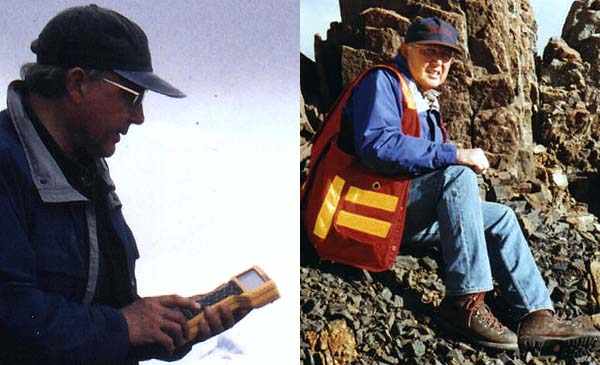
2001 Felix Chayes Prize for Excellence in Research in Mathematical Geology
of the International Association for Mathematical Geology

|
IAMG 2001--Cancún
2001 Felix Chayes Prize for Excellence in Research in Mathematical Geology |
|
Home Page
|
JAMES NICHOLLS
The Felix Chayes Prize for Excellence in Research in Mathematical Petrology is awarded in alternate years by the International Association for Mathematical Geology. The Prize is funded by an endowment in honor of the late Felix Chayes to an individual who has exhibited exceptional potential and proven research ability. The third Felix Chayes Prize winner is Professor James Nicholls of the University of Calgary. I first met Jim at a meeting of petrologists at Queen's University (Ontario) approximately fifteen years ago. I soon found his tranquil disposition and relaxed attire, jeans, cowboy boots and bolo-tie were very deceptive. He treated us to a penetrating lecture on the equilibrium thermodynamics and statistical properties of a geochemical data set from a series of Hawaiian basalts. In following meetings I found Jim's lectures always set the standard. It is most appropriate he receive this award because like Felix Chayes Jim has devoted his professional life to important problems within the discipline of mathematical petrology. All of Jim's work is done with characteristic rigour. It is evident that he takes great care to ask relevant scientific questions, formulate hypotheses, and test them in order to pose appropriate solutions to the questions. Moreover in his papers, he has always scrupulously analyzed the error associated with measurement. Jim has consistently learned new mathematical techniques as demanded by the problems he has tackled and has thus applied linear algebra, vector calculus, multivariate calculus, analysis of variance and Bayesian statistics to problems in petrology. Jim is a native of Idaho and attended Texas Christian University where he graduated with a B.Sc. and immediately left to commence Ph.D. studies with Ian Carmichael at Berkeley. He chose Berkley not because of the prestige associated with its name, but because of his wish to attain the best scientific education possible within his discipline. Work that he started there and continued during the 70's employed methods from multivariate calculus and was fundamental to the quantitative understanding of magmatic systems. As an example the classic paper (Nicholls et al. 1971) describes silica activity and Ptotal in igneous rocks. During the 1980's he turned his mathematical talents to analytical methods specifically the data of electron beam instruments. He and his colleague Mavis Stout (Calgary) published an influential paper that allows for the characterization of modes (i.e. the mineralogical composition of a rock), their spatial distribution and texture or pattern recognition using point counts of X-ray intensities (Nicholls and Stout 1986). Along this theme, Jim published an elegant paper on the relationship between electromagnetic radiation and the optical indicatrix for visible light in anisotropic minerals (Nicholls, 1996). Appropriate to this award, Jim has worked on a problem central to the use of geochemical data in order understand the geochemical evolution of igneous rock suites, the "Chayes Closure Problem". This problem, a variant of the constant sum effect, has been neatly solved (though not without contention) by the Pearce Element Ratio Technique developed by Tom Pearce (Queen's). Nicholl's 1988 paper demonstrates that Pearce's method is statistically valid, and that Pearce element ratio diagrams serve to depict processes leading to differentiation in igneous suites. Essentially the technique allows one to test petrologic hypotheses about differentiation having prior knowledge (in this case mineral stochiometry) of the differentiating phases within a magmatic system. Jim and his former Ph.D. student Kelly Russell (UBC) and their colleague Terry Gordon (Calgary) proceeded to use linear algebra in order to facilitate the use of complex numerators in Pearce element ratio diagrams, and to demonstrate applications related to the testing of petrologic hypotheses (Russell and Nichols, 1988; Nicholls and Gordon 1994). This led to Jim's work on Bayesian statistics and what will undoubtedly become a classic paper in the petrological literature (Nicholls 1998). Clearly there is a need to include qualitative data, such as the results of field mapping and microscopy into petrologic statistical methodology, and that Jim is breaking new ground in this domain with his application of Baye's Theorem. Professor Nicholls has not selfishly isolated himself in his research. He has been very active in teaching, and in service to the academic community. He has taught numerous courses, many outside his discipline, for instance; historical, environmental and engineering geology. I understand that these have been taught with Jim's customary rigour and also with a view toward the ethical development of his students. He has given, or participated in numerous short courses where he has made difficult subject matter accessible to others. He has served on several editorial boards and is the current past-president of the Mineralogical Society of Canada. Jim is presently working on methods to extend our thermodynamic data base for the modeling of magmatic systems to include volatile components. We look forward to seeing more of Jim's brilliant work in the future.
Dr. Anthony D. Fowler ReferencesRussell, J.K. and Nicholls, J., 1988. Analysis of petrologic hypotheses with Pearce element ratios. Contributions to Mineralogy and Petrology, 99, p. 25-35.Nicholls, J., Carmichael, I.S.E., and Stormer, J.C., Jr., 1971. Silica activity and P(total) in igneous rocks. Contributions to Mineralogy and Petrology, 33, p. 1-20. Nicholls, J. and Stout, M.Z., 1986. Electron beam analytical instruments and the determination of modes, spatial variations of minerals and textural features of rocks in polished section. Contributions to Mineralogy and Petrology, 94, p. 395-404. Nicholls, J., 1988. The statistics of Pearce element diagrams and the Chayes closure problem. Contributions to Mineralogy and Petrology, 99, p. 11-24. Nicholls, J. and Gordon, T.M., 1994. Procedures for the calculation of axial ratios on Pearce element-ratio diagrams. Canadian Mineralogist, 32, p. 969-977. Nicholls, J. 1996. Location of ray paths for a known wave normal in biaxial crystals. Canadian Mineralogist, 34: 161-170. Nicholls, J. 1998. Estimation of probabilities of three kinds of petrologic hypotheses with Bayes Theorem. Mathematical Geology, 30: 817-835. |